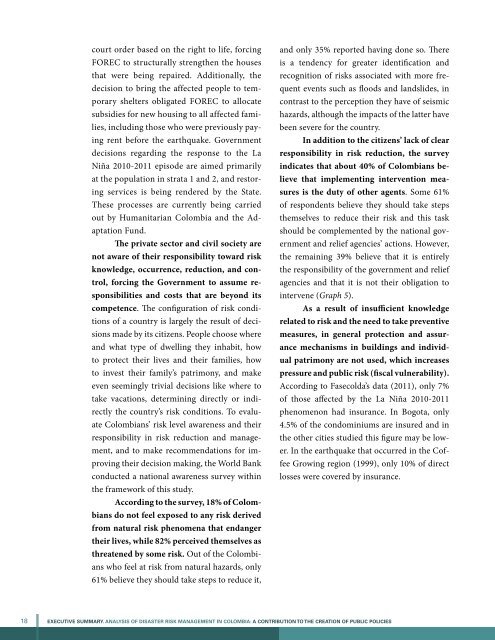Executive Summary - GFDRR
Executive Summary - GFDRR
Executive Summary - GFDRR
Create successful ePaper yourself
Turn your PDF publications into a flip-book with our unique Google optimized e-Paper software.
court order based on the right to life, forcing<br />
FOREC to structurally strengthen the houses<br />
that were being repaired. Additionally, the<br />
decision to bring the affected people to temporary<br />
shelters obligated FOREC to allocate<br />
subsidies for new housing to all affected families,<br />
including those who were previously paying<br />
rent before the earthquake. Government<br />
decisions regarding the response to the La<br />
Niña 2010-2011 episode are aimed primarily<br />
at the population in strata 1 and 2, and restoring<br />
services is being rendered by the State.<br />
These processes are currently being carried<br />
out by Humanitarian Colombia and the Adaptation<br />
Fund.<br />
The private sector and civil society are<br />
not aware of their responsibility toward risk<br />
knowledge, occurrence, reduction, and control,<br />
forcing the Government to assume responsibilities<br />
and costs that are beyond its<br />
competence. The configuration of risk conditions<br />
of a country is largely the result of decisions<br />
made by its citizens. People choose where<br />
and what type of dwelling they inhabit, how<br />
to protect their lives and their families, how<br />
to invest their family’s patrimony, and make<br />
even seemingly trivial decisions like where to<br />
take vacations, determining directly or indirectly<br />
the country’s risk conditions. To evaluate<br />
Colombians’ risk level awareness and their<br />
responsibility in risk reduction and management,<br />
and to make recommendations for improving<br />
their decision making, the World Bank<br />
conducted a national awareness survey within<br />
the framework of this study.<br />
According to the survey, 18% of Colombians<br />
do not feel exposed to any risk derived<br />
from natural risk phenomena that endanger<br />
their lives, while 82% perceived themselves as<br />
threatened by some risk. Out of the Colombians<br />
who feel at risk from natural hazards, only<br />
61% believe they should take steps to reduce it,<br />
and only 35% reported having done so. There<br />
is a tendency for greater identification and<br />
recognition of risks associated with more frequent<br />
events such as floods and landslides, in<br />
contrast to the perception they have of seismic<br />
hazards, although the impacts of the latter have<br />
been severe for the country.<br />
In addition to the citizens’ lack of clear<br />
responsibility in risk reduction, the survey<br />
indicates that about 40% of Colombians believe<br />
that implementing intervention measures<br />
is the duty of other agents. Some 61%<br />
of respondents believe they should take steps<br />
themselves to reduce their risk and this task<br />
should be complemented by the national government<br />
and relief agencies’ actions. However,<br />
the remaining 39% believe that it is entirely<br />
the responsibility of the government and relief<br />
agencies and that it is not their obligation to<br />
intervene (Graph 5).<br />
As a result of insufficient knowledge<br />
related to risk and the need to take preventive<br />
measures, in general protection and assurance<br />
mechanisms in buildings and individual<br />
patrimony are not used, which increases<br />
pressure and public risk (fiscal vulnerability).<br />
According to Fasecolda’s data (2011), only 7%<br />
of those affected by the La Niña 2010-2011<br />
phenomenon had insurance. In Bogota, only<br />
4.5% of the condominiums are insured and in<br />
the other cities studied this figure may be lower.<br />
In the earthquake that occurred in the Coffee<br />
Growing region (1999), only 10% of direct<br />
losses were covered by insurance.<br />
18 EXECUTIVE SUMMARY. ANALYSIS OF DISASTER RISK MANAGEMENT IN COLOMBIA: A contribution TO the creation of public policies

















